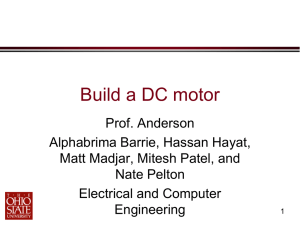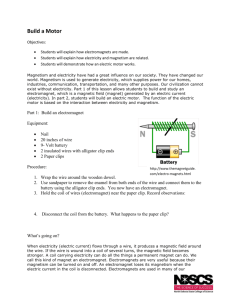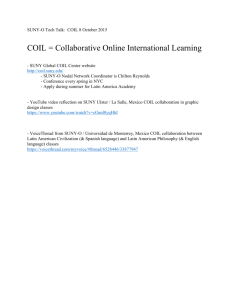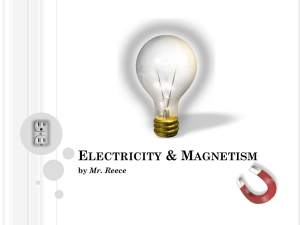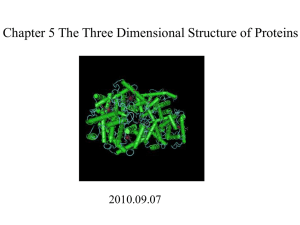Build a Motor
advertisement
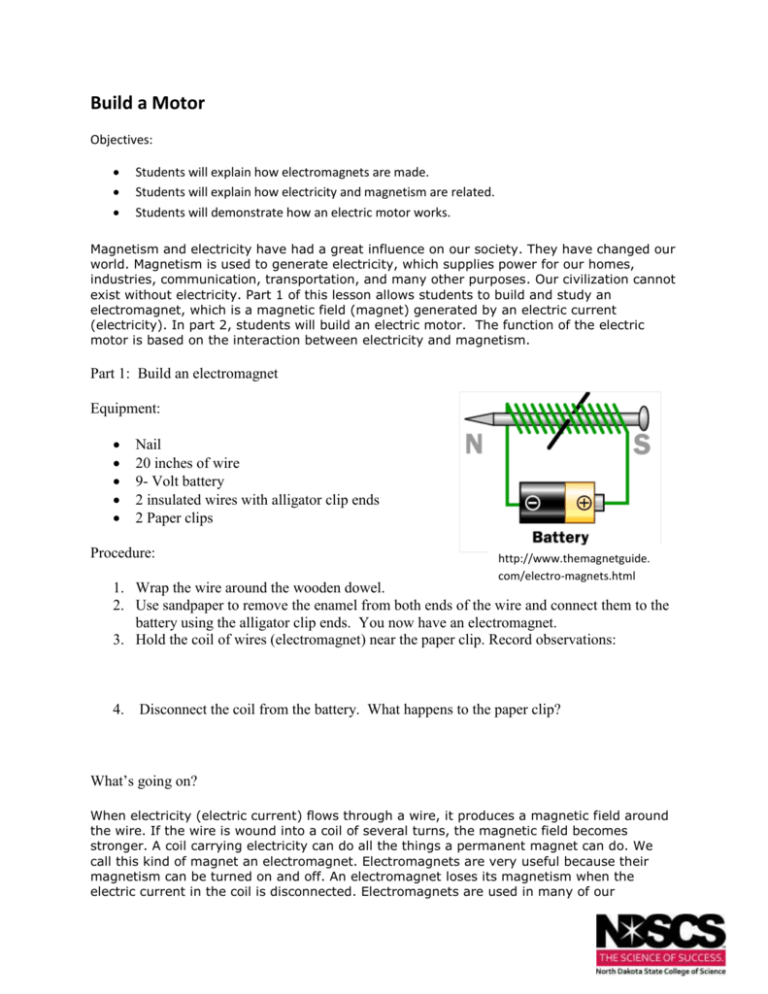
Build a Motor Objectives: Students will explain how electromagnets are made. Students will explain how electricity and magnetism are related. Students will demonstrate how an electric motor works. Magnetism and electricity have had a great influence on our society. They have changed our world. Magnetism is used to generate electricity, which supplies power for our homes, industries, communication, transportation, and many other purposes. Our civilization cannot exist without electricity. Part 1 of this lesson allows students to build and study an electromagnet, which is a magnetic field (magnet) generated by an electric current (electricity). In part 2, students will build an electric motor. The function of the electric motor is based on the interaction between electricity and magnetism. Part 1: Build an electromagnet Equipment: Nail 20 inches of wire 9- Volt battery 2 insulated wires with alligator clip ends 2 Paper clips Procedure: http://www.themagnetguide. com/electro-magnets.html 1. Wrap the wire around the wooden dowel. 2. Use sandpaper to remove the enamel from both ends of the wire and connect them to the battery using the alligator clip ends. You now have an electromagnet. 3. Hold the coil of wires (electromagnet) near the paper clip. Record observations: 4. Disconnect the coil from the battery. What happens to the paper clip? What’s going on? When electricity (electric current) flows through a wire, it produces a magnetic field around the wire. If the wire is wound into a coil of several turns, the magnetic field becomes stronger. A coil carrying electricity can do all the things a permanent magnet can do. We call this kind of magnet an electromagnet. Electromagnets are very useful because their magnetism can be turned on and off. An electromagnet loses its magnetism when the electric current in the coil is disconnected. Electromagnets are used in many of our machines. They are used in electric motors and generators. Electric motors run many of our appliances such as refrigerators, dishwashers, vacuum cleaners, blenders, video machines, power drills, etc. Part 2: Building an electric motor Equipment: 1 – 2 Magnets A 9V battery holder or connection clip 9V battery Some magnet wire such as Radio Shack #278-1345. We want enamel coated 22 gauge (or thicker) wire. We will only need about a yard of wire, so the Radio Shack package will make a dozen motors or more. Two paper clips for stands and some sandpaper to remove the enamel from the magnet wire. Wooden dowel NDSCS motor stand Procedure: 1. Wrap the wire around the wooden dowel approximately 20-30 times and remove the dowel. Use two pieces of scotch tape to keep the coils together if necessary or wrap the free ends around the coil to hold it in place. Leave the two ends sticking out about 1.5 inches. Carefully remove the wire. 2. Use sandpaper to remove the enamel completely from one end of the wire and then remove the enamel from only the bottom half of the other end of the wire. The idea behind sanding the wire is that the armature is going to rest on two supports made of paper clips. These supports will be attached to each end of the battery, so electricity can flow from one support into the armature and back through the other support to the battery. But this will only happen when the bare half of the wire is facing down, touching the supports. When the bare copper half is facing up, the insulated half is touching the supports, and no current can flow. 3. Insert the two paper clips into the white NDSCS base. This base is heavy enough so the motor won’t wobble and it has convenient holes in the plastic for you to insert the bare wire armature supports (paper clips). 4. Hang the coil from the paper clips. The coil should rest on the paper clip hooks with the enamel stripped ends of the coil in contact with the paper clips. Make sure the coil rotates smoothly. If it does not, adjust the shape of the coil until it does. 5. Use the wires with the alligator clips ends to connect the paper clips to the battery. 6. Give the coil a little push to get it started. If it does not start, push it in the opposite direction. The finished motor should look like this: 7. Experiment with the motor. What happens if the magnet is removed? What happens if you add more magnets? What’s going on? When electricity (electric current) flows through the coil, it creates a magnetic field around the coil. The coil becomes a magnet (electromagnet). The like poles of the coil and the magnet repel each other causing the coil to rotate. Just as the unlike poles of the coil and magnet are about to align, which will cause the coil to stop rotating, the flow of the electricity in the coil is cutoff eliminating the magnetic field of the coil. This happens when the enamel at one end of the wire that makes up the coil comes in contact with the paper clip during rotation. The momentum of the coil allows it to continue to rotate. As the coil rotates, the electricity in the coil is reestablished, which happens when the enamel stripped bottom half of the end of the coil comes in contact with the paper clip. The process continues and the coil keeps rotating. Conclusions: 1. When building an electromagnet, what do you predict would happen if you had twice as many turns in your wire? It would be twice as strong. 2. What happened when the paper clip got close to the electromagnet coils? It was attracted to the coil. 3. When building the electric motor, why do you need to sand only the bottom of one of the ends? What do you predict would happen if you sanded the entire end? The like poles of the coil and magnet cause the coil to rotate. When the unlike poles of the coil and magnet are about to align the flow of the electricity to the coil is cut off because the coil is only sanded on one half of one of the sides. The momentum of the coil forces it to finish spinning until the electricity is reestablished when the stripped enamel side of the end of the coil comes back in contact with the paper clip holder. 4. What is the relationship between electricity and magnetism? Electricity can produce a magnetic field, and a magnetic field can produce electricity 5. What are some appliances that could be run by electromagnetic motors? Electric motors run many of our appliances such as refrigerators, dishwashers, vacuum cleaners, blenders, video machines, power drills, etc.
